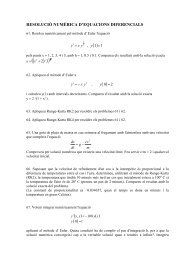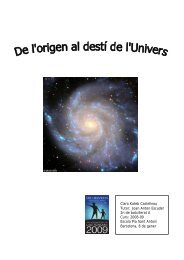Universitat de - Departament d'Astronomia i Meteorologia ...
Universitat de - Departament d'Astronomia i Meteorologia ...
Universitat de - Departament d'Astronomia i Meteorologia ...
You also want an ePaper? Increase the reach of your titles
YUMPU automatically turns print PDFs into web optimized ePapers that Google loves.
2.4. The radio counterpart: NVSS J182614−145054 45<br />
Flux <strong>de</strong>nsity [mJy]<br />
Spectral in<strong>de</strong>x<br />
100<br />
80<br />
60<br />
40<br />
20<br />
0<br />
0<br />
−1<br />
−2<br />
GBI−NASA Monitoring Program (Set2 data)<br />
2.25 GHz<br />
8.3 GHz<br />
−3<br />
51795 51800 51805 51810 51815 51820 51825<br />
Modified Julian Date [JD−2400000.5]<br />
Figure 2.5: Same as Fig. 2.4 for the Set2 data. The flare is probably false (see text).<br />
light curve in Fig. 2.5 to comment on the intriguing flare seen at 8.3 GHz around<br />
MJD 51803. Although there could be an increase in flux <strong>de</strong>nsity at 2.25 GHz, thus<br />
supporting a possible outburst, the GBI operational notes reveal that spikes were<br />
occasionally occurring at that time, and it is stated that single high scans should be<br />
ignored. Hence, we conclu<strong>de</strong> that the flare shown in Fig. 2.5 is probably false.<br />
Conclusions<br />
LS 5039 is a persistent radio source. In the GBI monitoring it is clearly <strong>de</strong>tected<br />
at 2.25 GHz, with a mean flux <strong>de</strong>nsity of ∼ 31 mJy, and marginally <strong>de</strong>tected at<br />
8.3 GHz, with a mean flux <strong>de</strong>nsity of ∼ 14 mJy. The spectral in<strong>de</strong>x of the source is<br />
α ∼ −0.5, confirming earlier results. In addition to the negative spectral in<strong>de</strong>x, the<br />
brightness temperature estimates for LS 5039 clearly yield to non-thermal values,






